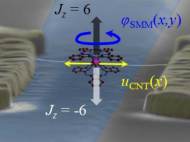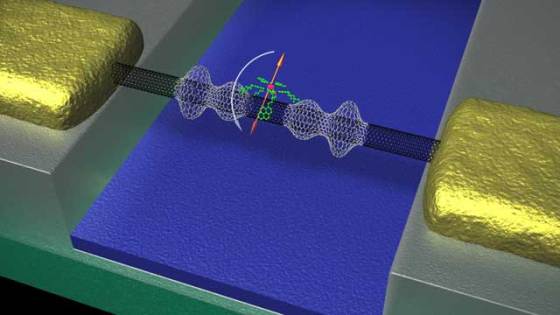Electronic read-out of quantum spin states achieved
 Researchers of Karlsruhe Institute of Technology and French colleagues from Grenoble and Strasbourg have found a way to combine carbon nanotubes and magnetic molecules on the atomic level in order to build a quantum mechanical system with novel properties. This vibrating system offers new opportunities in quantum computing by adding a vibration variable to spin and rotation quantum states.
Researchers of Karlsruhe Institute of Technology and French colleagues from Grenoble and Strasbourg have found a way to combine carbon nanotubes and magnetic molecules on the atomic level in order to build a quantum mechanical system with novel properties. This vibrating system offers new opportunities in quantum computing by adding a vibration variable to spin and rotation quantum states.
The researchers used a carbon nanotube and mounted it between two metal electrodes that are about 1 µm, apart. This setup allows the system to vibrate mechanically. In the next step, they applied an organic molecule with an incorporated metal atom which enables magnetic spin of the molecule. This spin was oriented in an external magnetic field.
“In this setup, we demonstrated that the vibrations of the tube are influenced directly when the spin flips parallel or antiparallel to the magnetic field”, said Mario Ruben, head of the research group at KIT.
When the spin changes, the resulting recoil is transferred to the carbon nanotube and the latter starts to vibrate. Vibration changes the atomic distances of the tube and, hence, its conductance that is used as a measure of motion.
The strong interaction between a magnetic spin and mechanical vibration opens up interesting applications apart from determining the states of motion of the carbon nanotube. It is proposed to determine the masses of individual molecules and to measure magnetic forces within the nano-regime.
KIT researchers envision that such interactions are of high importance in the quantum world, i.e. in the range of discrete energies and tunnel effects, for the future use of nanoscopic effects in macroscopic applications.
Combination of spin, vibration, and rotation on the nanoscale in particular may result in entirely new applications and technologies, as well as use as a quantum bit variable in a quantum computer. Before getting your hopes up, I have to add that these results were observed at temperatures close to absolute zero (ranging from 20 to 700 mK).
For more information, read the article published in Nature Nanotechnology: “Strong spin–phonon coupling between a single-molecule magnet and a carbon nanotube nanoelectromechanical system“










Leave your response!